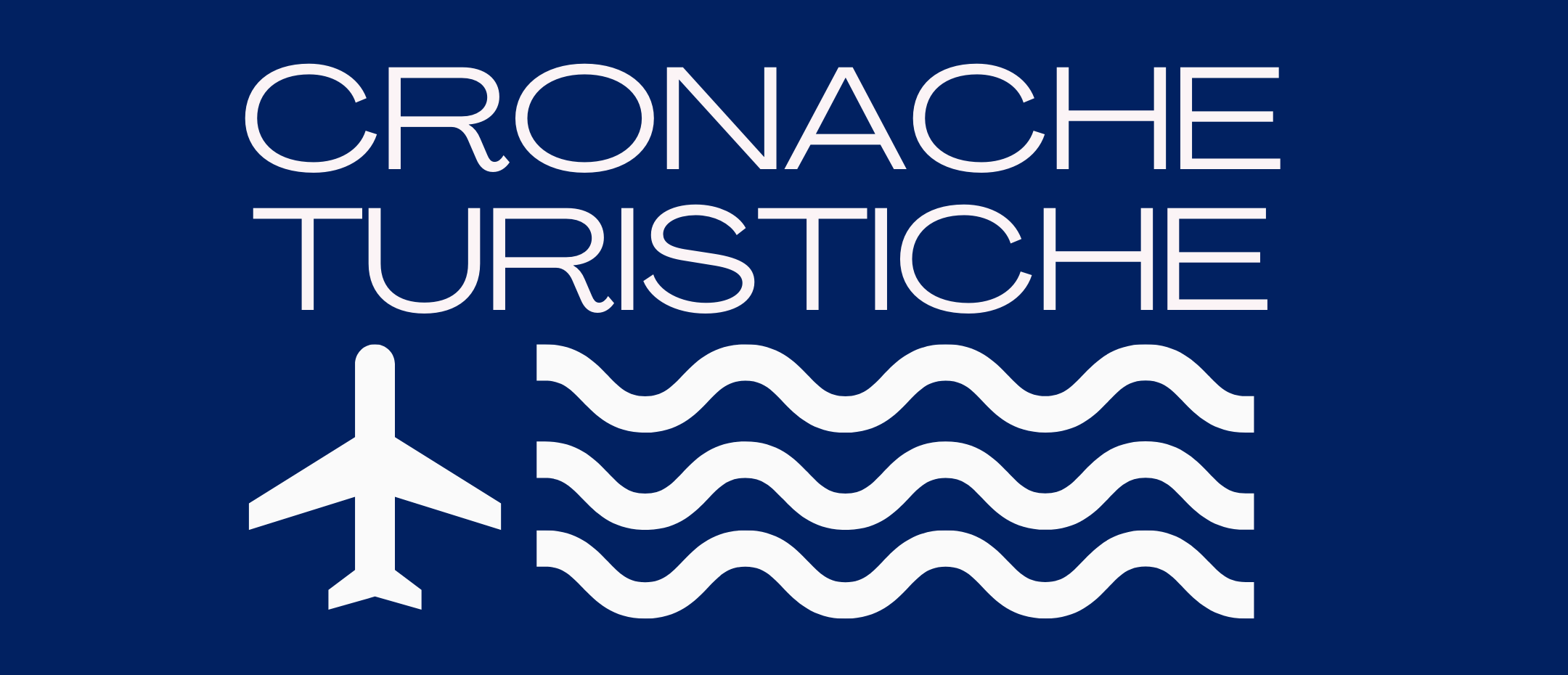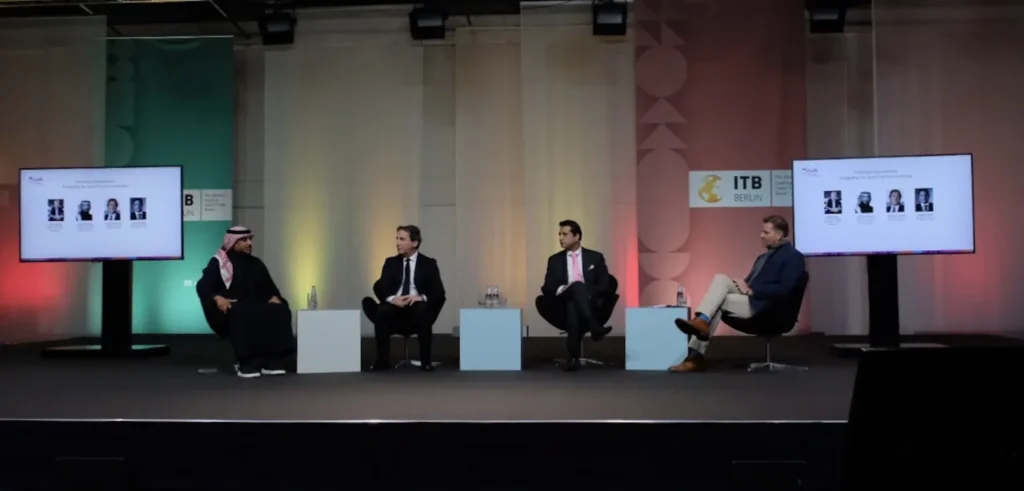
In a press roundtable discussion organised by the Saudi Tourism Authority at ITB Berlin, entitled “Unlocking opportunities – navigating the Saudi tourism landscape”, industry leaders gathered to discuss the rapid advancements and ambitious future of Saudi Arabia’s tourism sector. Kai Böcking, host and publisher at Bleisure Traveller Magazine, facilitated the dialogue, focusing on the significant strides made by the Kingdom in the past year.
The panel session peeled back the layers of Saudi Arabia’s tourism landscape, revealing a country on the precipice of a major tourism revolution, firmly grounded in sustainable development and robust international partnerships. The overarching message was clear: Saudi Arabia is open for exploration, and the world is invited to witness its transformation first-hand.
Following are our ten key take-aways from today’s session:
- 1. Significant Investment in Tourism: Saudi Arabia is making a major push into the tourism sector with an investment of 800 billion USD, aiming to attract 150 million tourists by 2030. The country has already seen a notable increase in tourist arrivals, reaching 27.4 million in 2023.
- 2. Expansion of Luxury Accommodations: The launch of high-end properties such as the Saint Regis and Six Senses resorts in the Red Sea region showcases Saudi Arabia’s commitment to offering premium experiences to international travellers.
- 3. Visa and Accessibility Improvements: The introduction of the 96-hour stopover visa and other visa reforms, as well as increased flight capacity from the UK, are part of efforts to make Saudi Arabia more accessible to international tourists.
- 4. Redefining Saudi Arabia’s Image: The panelists highlighted efforts to reshape the global perception of Saudi Arabia through direct storytelling and engagement, combating previous misconceptions and inviting travellers to experience the country’s culture and hospitality firsthand.
- 5. Role of Digital and Social Media: Enhanced social media campaigns have been instrumental in raising awareness about Saudi Arabia’s tourism offerings and increasing its appeal, particularly in the European market.
- 6. Diverse Tourist Interests: Saudi Arabia is positioning itself as a destination with a wide array of attractions for different types of tourists, from cultural and historical explorers to sports enthusiasts and luxury seekers.
- 7. Event-Driven Tourism: A packed events calendar, featuring cultural festivals and international sports events, is set to attract visitors looking for unique experiences.
- 8. Sustainability as a Core Principle: Saudi Arabia is placing a strong emphasis on sustainable development, ensuring that tourism growth does not come at the expense of environmental conservation.
- 9. Trade and Partner Engagement: The Kingdom is focused on building and strengthening partnerships with trade partners to support and enhance the selling of Saudi travel experiences globally.
- 10. An Invitation to Witness Transformation: The roundtable concluded with an open call for people to visit Saudi Arabia, experience its offerings, and see the country’s evolution in tourism and hospitality for themselves.
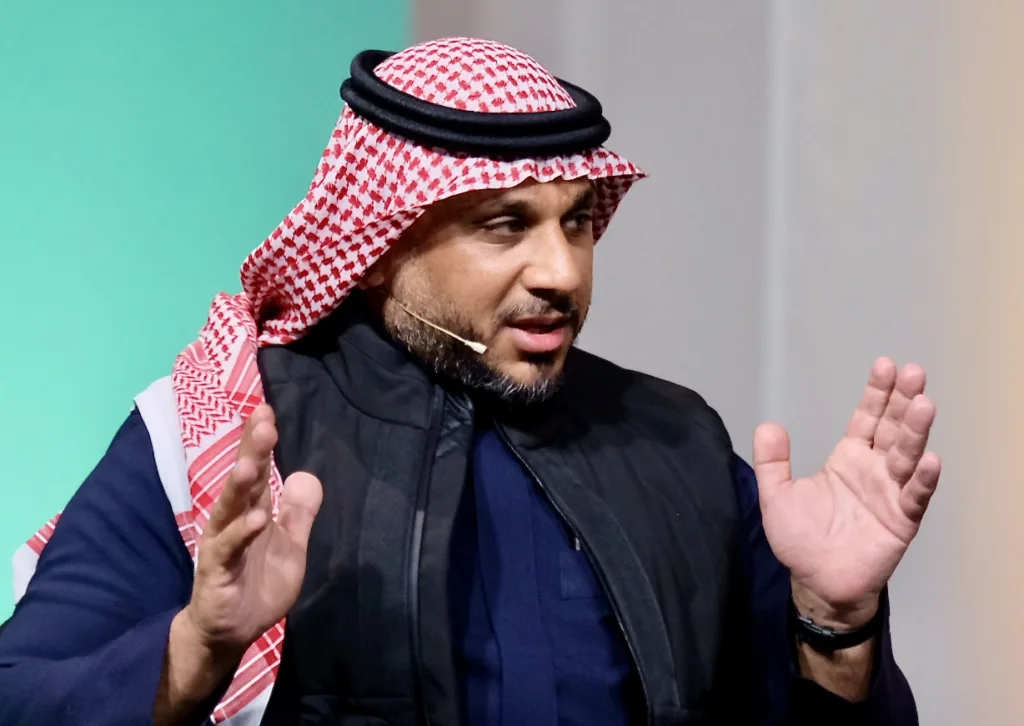
Hazim AlHazmi, President of Europe & Americas at the Saudi Tourism Authority, opened with a confident affirmation of the country’s progress: “It is definitely getting real,” he asserted, reflecting on the previous year’s announcements of extensive projects and investments. Saudi Arabia has escalated to become the world’s preeminent investor in tourism, committing a staggering USD 800 billion to the sector. The nation’s goal is to welcome 150 million tourists by 2030—a target that seems increasingly attainable as the Kingdom reported an impressive 27.4 million foreign visits in 2023, placing it 12th globally for inbound tourism.
Highlighting tangible progress, AlHazmi shared news about the Red Sea project, “Today, I’m very happy to announce that there are two live properties that you can book right away, the Saint Regis and the Six Senses Southern Dunes resorts in the Red Sea,” offering a luxurious, top-tier global experience.
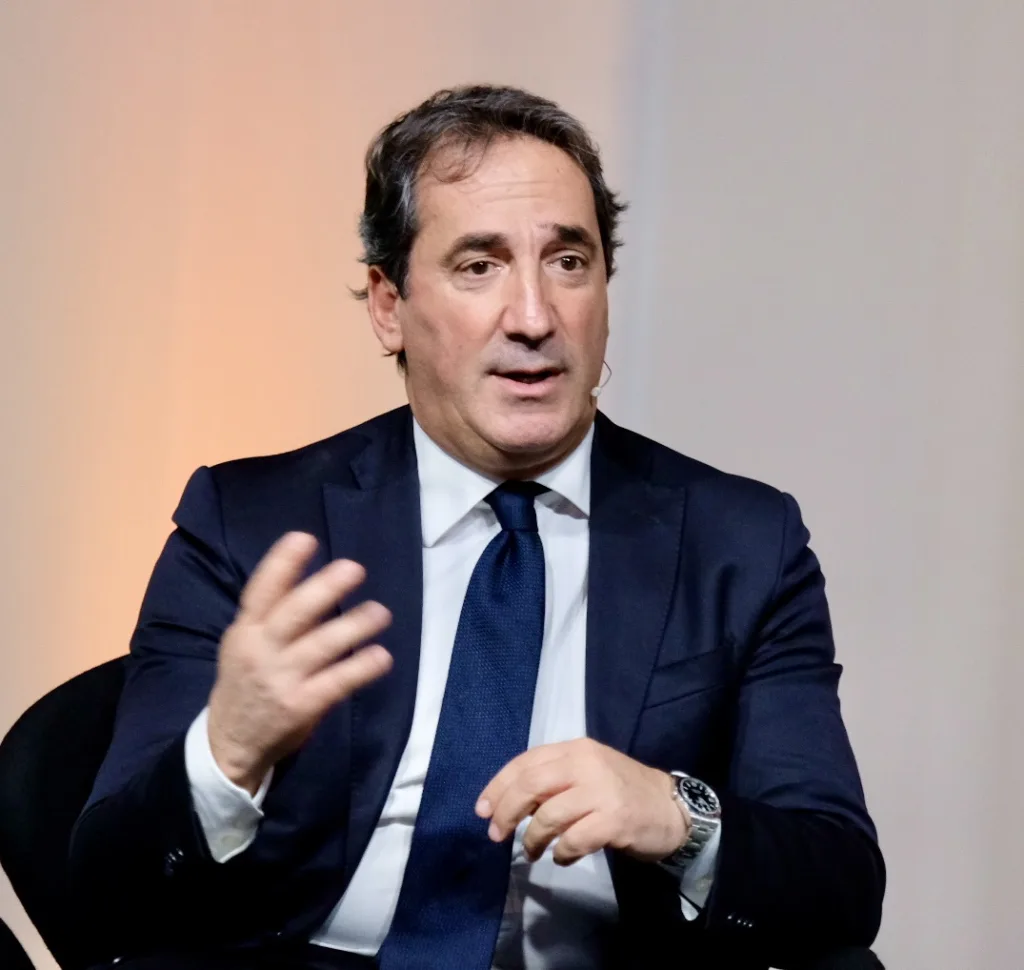
Andrea Vannucci, General Manager of Sporting Vacanze, provided insights into the Italian market’s engagement with Saudi tourism. He shared his astonishment at the country’s beauty and the warmth of its people, noting the significant alignment with their portfolio. Vannucci also emphasised the critical role of tour operators in crafting and conveying the narrative of a destination like Saudi Arabia, which demands a more profound storytelling approach than what is offered by online platforms.
Vannucci expressed confidence in the destination’s growth, “Absolutely, it’s going up,” he affirmed, mentioning the impact of social media in raising awareness and interest in Saudi Arabia. The destination’s appeal has been significantly bolstered by impressive campaigns and promotional activities.
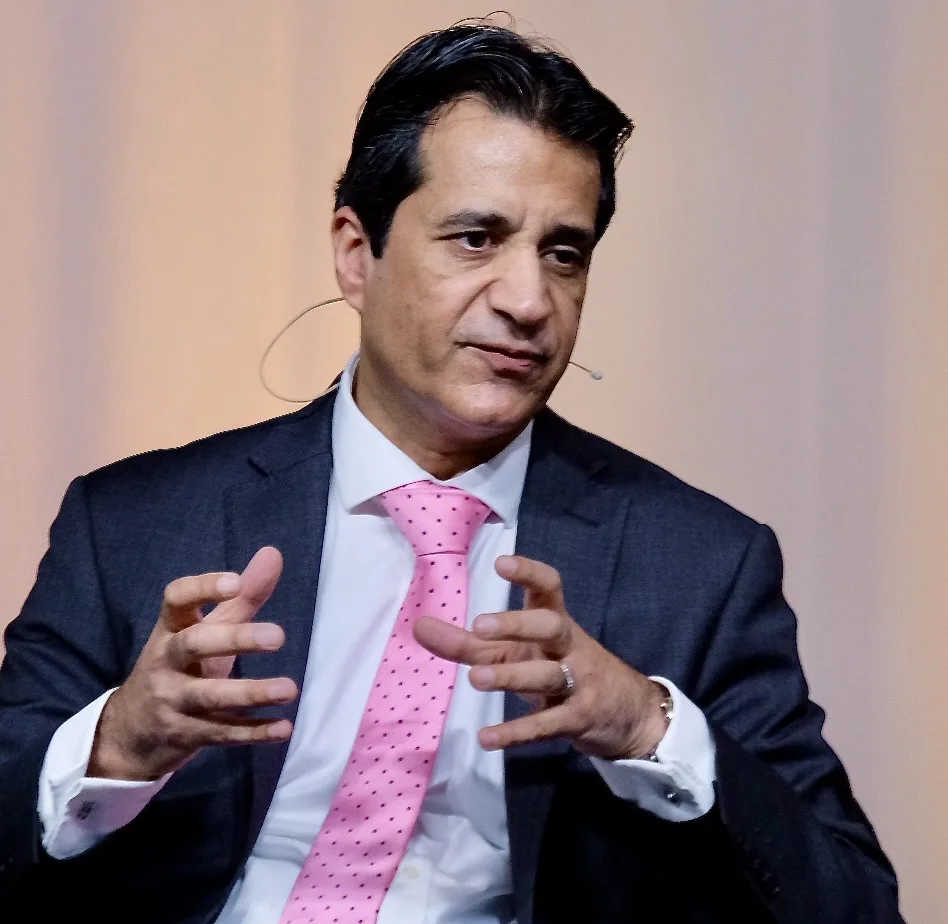
Deepak Nangla, Managing Director at Brightsun Travel, introduced his company’s bullish stance on Saudi tourism. He recounted the evolution of their partnership with the state, which began three years ago, focusing primarily on the religious market but has since expanded. Nangla highlighted the Kingdom’s responsiveness to suggestions, citing the expedited E-visa process as a game-changer and the increase in flight capacity to Saudi Arabia from the UK as pivotal improvements.
Nangla’s optimism was evident as he described the emerging picture of Saudi Arabia’s place on the global map. The efforts by the Saudi government and the resultant developments indicate that Saudi Arabia is not just participating in the global tourism landscape but is swiftly moving to redefine it.
As the conversation shifted towards the advancements in visa accessibility, AlHazmi highlighted the country’s steadfast efforts to streamline entry processes, thus enhancing the ease of travel to the Kingdom. The introduction of innovative visa schemes, like the 96-hour stopover visa paired with complimentary accommodation offerings, exemplified Saudi’s commitment to boosting accessibility. AlHazmi noted that in response to market demands, including suggestions from Deepak Nangla, the Kingdom is also exploring cost-effective options for short stays.
AlHazmi continued, underscoring the massive promotional campaigns aimed at educating consumers on Saudi Arabia’s rich heritage and contemporary allure. “Saudi. Welcome to Arabia, the authentic home of Arabia,” he declared, emphasizing the intensive online and offline efforts to elevate the Kingdom’s tourism brand. He acknowledged the competitive nature of the market, indicating the rigorous measures Saudi Arabia is taking to carve out a significant presence in the global tourism landscape.
The discussion then delved into the European market’s perception of Saudi Arabia, a region that presents its own set of challenges due to preconceived notions about the country. AlHazmi emphasized the importance of combating these misconceptions by inviting people to experience Saudi culture first-hand, confident that the first visit often leads to a desire to return and share stories.
Andrea Vannucci of Sporting Vacanze addressed common queries from potential travellers, primarily concerning safety—a concern he quickly dispelled, praising Saudi Arabia as one of the safest destinations he’s visited. He echoed AlHazmi’s sentiments regarding the importance of delivering an accurate portrayal of the country, an effort bolstered by the passionate energy emanating from Saudi’s leaders.
Nangla confirmed the safety concerns but noted that for those already visiting for religious purposes, there was a desire to expand their experience beyond pilgrimage. He highlighted the importance of cultural integration and the breaking of barriers as key to changing perceptions.
When asked about the driving factors behind the increasing interest in Saudi tourism, Hazim painted a picture of a land offering unique cultural adventures and authentic Arabian experiences, from its undiscovered territories to a burgeoning portfolio of premium and luxury offerings. The country is positioning itself as a destination for curious and open-minded travellers, eager for new experiences in culture, sports, arts, and cuisine.
Saudi’s cultural proposition is further enriched by a robust events calendar, including 17,000 events from sports to cultural festivals, catering to various interests and demographics. With ambitious plans to introduce even more high-profile attractions like Six Flags, Saudi is strategically curating a diverse and appealing tourism experience aimed at a wide range of international visitors.
At the core of the roundtable discussion, a key theme emerged: accessibility and the transformative journey of Saudi tourism. The panelists engaged in a rich discourse about the evolving travel dynamics within the Kingdom, anchored by Kai Böcking’s astute inquiries into the current state and future aspirations of the Saudi travel landscape.
Hazim, speaking with a true sense of commitment, illustrated the Kingdom’s strides in enhancing visitor accessibility. “Part of accessibility is the regulation related to the visa,” he explained, detailing initiatives like the 96-hour stopover visa and exploring cost-effective options for short stays to boost accessibility further. He also highlighted Nangla ‘s request for consumer education about Saudi as a travel destination, shedding light on the massive investment in brand-building through campaigns and activations.
Self-drive still some time off
Nangla contributed to the conversation by shedding light on the evolving nature of travel in Saudi Arabia. Self-drive options may still be on the horizon, but the infrastructure for guided tours is robust and expanding. He spoke with anticipation about a luxury train reminiscent of the Orient Express, set to connect vital Saudi cities, opening up new avenues for a variety of travellers.
Andrea’s insights reflected the growing curiosity and demand for Saudi Arabia’s unique offerings, from the untapped potential for historical and archaeological exploration to the burgeoning sports tourism spurred by high-profile events and celebrity athletes. He shared visions of marathons across the majestic landscapes of AlUla and special tours tracking the thrilling Dakar Rally, emphasizing the creative role of tour operators in crafting unforgettable experiences.
Nangla’s perspective on customer curiosity underscored the shifts in perception about Saudi tourism. The religious travellers, already familiar with the Kingdom, are now broadening their horizons, while new visitors are intrigued by cultural and sporting events.
The conversation pivoted to the diverse reasons that now draw visitors to Saudi Arabia. AlHazmi eloquently stated that the country offers a unique blend of cultural adventure and connection. “Saudi has something very unique to offer… the authentic home of Arabia,” he said, noting the Kingdom’s appeal to those seeking new experiences, cultural immersion, and luxury travel. He delved into the Kingdom’s segmentation approach, tailoring experiences to visitor motivations and barriers, and elaborating on the expanding offerings, such as luxury resorts along the pristine Red Sea coast.
AlHazmi also tackled the challenging perceptions in Europe, emphasizing the importance of sharing Saudi Arabia’s story authentically and inviting people to experience the country firsthand. This initiative aims to transform misconceptions and solidify Saudi Arabia’s reputation as a welcoming and intriguing destination.
Sustainability was another focal point, with Kai highlighting the significance of environmental conservation in Saudi Arabia’s development plans. AlHazmi responded passionately, describing the conscientious decisions made to preserve the natural habitats of the Red Sea’s islands, even at the expense of lucrative development opportunities. He stressed the Kingdom’s commitment to sustainable practices and invited the audience to research the ambitious Neom and Red Sea projects.
Kai raised the point of sustainability as a selling feature, suggesting the growing importance of environmental responsibility to travellers. This attention to sustainability as a critical factor in the decision-making process of travellers highlights a global trend towards more ecologically conscious tourism.
The roundtable revealed a Saudi Arabia at a crossroads of tradition and innovation, of expansion and preservation, poised to redefine its place in the world as a leading destination that holds authenticity, adventure, and sustainability at its heart.
The discussion concluded with a forward-looking perspective from STA’s AlHazmi. Reiterating their commitment to sustainable growth, he emphasised the strategic long-term vision of the Kingdom’s tourism sector. “We are not building things as a fad or for the short term,” he stated, outlining the Kingdom’s focus on delivering enduring value and experiences to tourists.
With a remarkable milestone of 27 million foreign visitors the previous year, AlHazmi laid out the roadmap to achieving an ambitious goal of 150 million visits by 2030. This vision is backed by significant investments across the tourism value chain, from enhancing air connectivity—with an additional ten routes to the existing 26 in Europe—to expanding accommodation options with a half billion room keys anticipated by year-end.
AlHazmi underscored the importance of partnerships in this journey, highlighting the investment in educating trade partners, crafting incentive schemes, and engaging in co-marketing initiatives to make selling Saudi profitable and appealing.
The conversation wrapped up with an invitation to all attendees to visit their booth at the ITB, a space designed to immerse visitors in Saudi culture and offerings. Hazim encouraged everyone to research Saudi Arabia and to listen to the testimonials of the millions who have visited and left with joyous experiences.
Kai closed the discussion with a succinct takeaway: “Go to Saudi. Make your own picture.”
